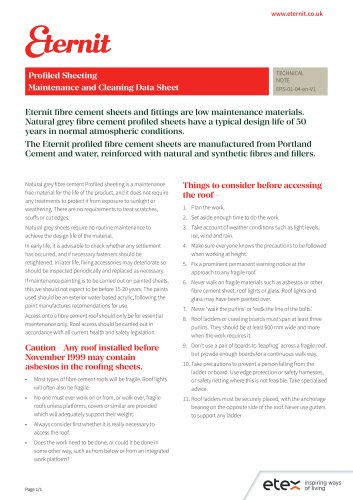
Catalog excerpts

Ventilation Guide Livestock building design & material guide
Open the catalog to page 1
The internal environment in livestock buildings cannot be ignored As livestock producers are now targeted to manage antibiotic use by focusing on disease prevention. A well designed livestock building can help you in this task;
Open the catalog to page 2
Pneumonia causes significantly lower growth rates and increased treatments contributing the greatest costs, shows research from Scarsdale Vets. “50% of naturally ventilated buildings assessed are not competently ventilated” Jamie Robertson, Livestock health specialist and honorary research fellow at Aberdeen University The factors above drive the necessity to maximise production and increase profitability, one thing becomes clear – livestock producers are under immense pressure. Whether it’s an existing building undergoing refurbishment or a new build, design and materials for improved...
Open the catalog to page 3
Unprotected open ridge Low pressure Wind Warm, moist air leaves through roof apertures Air warms and picks up moisture High pressure Protected open ridge Natural ventilation requires careful planning Maintaining adequate ventilation comes down to two things: managing wind impact and the physics of the air inlet/air outlet cycle. As livestock expel warm air which may contain bacteria and viruses, it rises to the top of the building – making air inlets essential to support air movement in the absence of wind. Stack effect ventilation for cattle The stack effect provides effective and natural...
Open the catalog to page 4
Eternit has products to suit any air outlet requirements Breathing and spaced roofs For livestock buildings air outlet can be obtained from multiple products and designs including open ridge upstands, spaced roofs and raised sheets. However advice should be sought for calculation purposes. Contact infouk@etexgroup.co.uk to find out more. While open ridges should be the main method of providing high level ventilation, spaced roofs or breathing roofs can be used in conjunction with open ridges when additional ventilation is required. Not only do these designs decrease condensation, but they...
Open the catalog to page 6
Air inlets provide constant air flow Things such as pen walls, partitions and feeders can prohibit air movement in naturally ventilated livestock buildings and must be kept in consideration. Air inlet for cattle buildings According to AHDB, design for air inlet should consist of two evenly split sidewalls that are four times the size of the outlet area to maintain air flow throughout the building while reducing airspeed at animal height. • For example, if a dairy building is 30 metres long and 20 metres wide containing 100 cows, then it needs a minimum of 10m2 of hole space to get adequate...
Open the catalog to page 7
Roofing materials make a difference When selecting roofing material for livestock buildings, the overall production picture needs to be looked at with a focus of maintaining a stable building environment rather than choosing the cheapest option. Metal Sheet disadvantages For example it has several downsides that can end up costing livestock producers more long-term in production. • Noise levels in hail or heavy rain on metal sheeting are much higher than fibre cement, significantly increasing cow discomfort which leads to a reduction in productivity • High thermal conductivity creates...
Open the catalog to page 8
Telephone: 01283 501555 Email: infouk@etexgroup.com or visit: eternit.co.uk Etex (Exteriors) UK, Wellington Road, Burton-upon-Trent, Staffordshire, DE14 2AP Visit our website to see FarmTec • Case Studies & Inspiration • Technical Product Information • Brochures and Technical PDFs Changes in the meantime are reserved. Issued: June 2023 All previous issues here within lapse, with this edition. Nothing contained in this printed document may be reproduced and/or publicised, either in printing, photocopying, as microfilm or by other means without prior written approval from the issuer. This...
Open the catalog to page 9All Euronit catalogs and technical brochures
-
FarmTec
14 Pages












